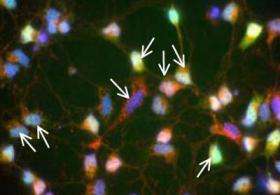New clues about mitochondrial 'growth spurts'

Mitochondria are restless, continually merging and splitting. But contrary to conventional wisdom, the size of these organelles depends on more than fusion and fission, as Berman et al. show. Mitochondrial growth and degradation are also part of the equation.
The study will appear online March 2, 2009 and in the March 9, 2009 print issue of The Journal of Cell Biology (JCB).
Fission is necessary to produce new mitochondria, such as those that power synaptic activity in healthy neurons. Fusion is also important. It goes awry in one form of Charcot-Marie-Tooth disease, in which peripheral nerves deteriorate, and in other neurodegenerative diseases. How cells manage mitochondrial size and number remains unclear.
Berman et al. found a clue when they started refining measurements of mitochondrial dynamics. The team labeled the organelles with a red fluorescent protein and a light-activated green fluorescent protein. By switching on the green marker with a laser and then looking for the mixing of colors, the researchers could distinguish mitochondrial mergers from near misses. To their surprise, they found that in healthy neurons, fission occurs up to six times more often than fusion.
So why aren't the cells cluttered with tiny mitochondria? Because the organelles grow longer, the researchers determined. This size increase offsets the higher fission rate. The researchers also surmised that to "balance the books," another process has to be operating—mitochondrial degradation. Together, fusion, fission, growth, and breakdown determine mitochondrial size and shape, Berman et al. propose.
Orchestrating many of these changes is the protein Bcl-xL. The team found that it spurred mitochondrial elongation and sped up fission and fusion. Without Bcl-xL, mitochondria became stumpy and seemingly less energy efficient. Bcl-xL belongs to the Bcl-2 protein family, whose members can protect mitochondria or shatter them to drive apoptosis. Berman et al.'s results suggest that Bcl-xL manages the number, size, and energy-producing capacity of mitochondria long before the cell is faced with a life-or-death decision. Still a mystery, the scientists say, is how Bcl-xL sparks mitochondrial growth.
More information: Berman, S.B., et al. 2009. J. Cell Biol. doi:10.1083/jcb.200809060. www.jcb.org
Source: Rockefeller University Press





















